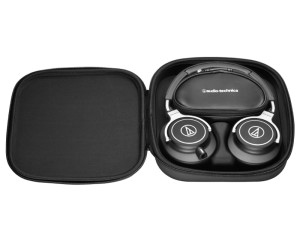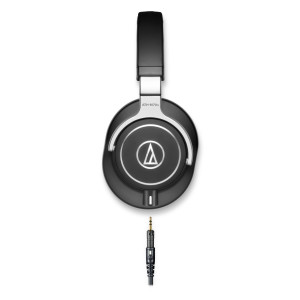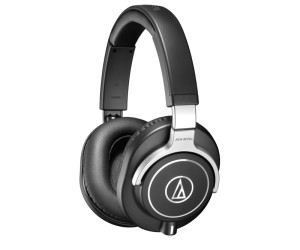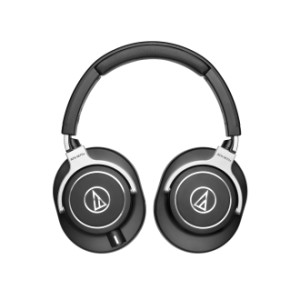Review: Audio-Technica ATH-M70x Headphones
In both music and audio post work, there are a lot of situations where headphones are a necessity. Voice over and foley recording require headphones, you may find several pairs floating around in music tracking sessions, and you never know when you’ll have to plug into a laptop for some editing.
I prefer to use great-sounding headphones that I’m already familiar with, but when working in commercial facilities, over-attachment to a specific pair of phones can lead to heartache. Different studios have different types, things get moved around and left behind, things get borrowed, things get trampled.
Having your own pair of high-quality headphones that you know and trust can be a lifesaver in this context. And, now that I have my own studio, I thought it would be a good time to re-evaluate my own headphone situation and try some new options, including the ATH-M70X.
The Basics
The ATH-M70x is the flagship model of Audio-Technica’s “M” Series, their line of professional studio headphones. (They also have open-back sibling, the ATH-R70x.) The M70x features 45mm large aperture drivers with rare earth magnets. The circumaural ear cups cover your ears for isolation, swiveling 90 degrees, for portability and one ear monitoring. Earpads and headband detach for easy replacement and three detachable cables are provided. The frequency response is stated to be 5-40,000 Hz, sensitivity is 97 dB, with impedance of 35 ohms. A carrying case is included along with a sheet of simple instructions. This unit is recommended for studio work, DJing, mastering, post-production, forensics and personal listening.
In Use

Semi-rigid carrying case for the M70x. The whole package can be found for a street price of about $300.
The headphones arrived in a very nice semi-rigid carrying case. The ear cups fold flat, and fit snugly into molded forms built into the case. Under the headband is a pouch for three different detachable cables.
One obvious benefit here is a simple replacement if a cable is damaged or otherwise fails. Another is that the user can choose the cable to suit the situation.
The connection on the side of the earcup is proprietary. It’s somewhat smaller than a standard 1/8″ stereo jack, with a twist-lock casing that fastens the cable easily and securely to the phones. There is one short and one long cable that terminate in stereo 1/8″ males and, much to my delight, a coiled cable that terminates in a combo 1/8″, along with a 1/4″ male adapter for all cables.
I initially thought it would have been better to make the connector to the cans themselves a standard 1/8” plug as well, for easy replacement, but given that it has to lock in place, and ships with three cables, I came to see it as a non-issue.

A custom locking connector allows for easy replacement or swapping between the three provided cables.
The headphones feel substantial, but not too heavy. I wore these phones for hours at a time and never felt uncomfortable. Because I wear glasses, discomfort is something I usually expect with long term use of headphones, but I didn’t get that with the M70x’s.
The build quality is nice, and some kind of damping has been employed on the various moving parts of this unit, so adjusting to fit feels luxurious and smooth. Nothing is rattles around or feels loose.
Most of the phones in my studio have the L or R side labeled clearly on the outside of the ear cup. The M70x’s are discreetly embossed on the inside of the band over the ear cup. I had to look around to find it. I like that only I will know if I put these on backwards.
The Sound
It took me a little while to settle into the sound of these. Full disclosure: I love open-air headphones, because I think they sound and react much more like speakers. But the leakage of open-back headphones makes them a no-go in many situations, like recording overdubs or in shared studio workspaces.
Having said that, the sound quality of these is great. The frequency response feels flat, and the sound is nicely defined without over-emphasizing the highs. Low frequencies are tight and powerful, and the imaging is accurate—good for judging subtle panning and and FX.
I didn’t hear any annoying resonances or other artifacts relating to their construction, and I would say that the comfort of using these extends to the listening. I’ve been enjoying tracking with them and would happily use them every day. It’s wonderful to be able to listen to a mix without hearing the influence of my room.
These phones provide a reliable reality check, especially for music work. They are not geared toward DJs and consumers who want overly-hyped bass and serve as a reliable studio reference. Though I don’t use headphones for sound-to-picture mixing for a number of reasons, for every other post-production and music application, these would be a suitable high-end choice.
Further Thoughts
I liked that the cups swivel flat for storage. Zipping them into the carry case provides a very safe and portable way to transport the phones without damaging delicate components. The case is a little smaller than a pork-pie hat, and fits easily into a shoulder bag along with a laptop and other rectangular items. In comparison, when I collapse the cups into the headband of my old-school Sony MDR-7506 headphones, the form factor for transport is more of a wadded-up ball shape.
Compared to the ubiquitous 7506 headphones, I’m going to give the A-T’s the edge on transport: Using this kind of packaging is fussier than I’m used to, but if I’m going to spend a few hundred dollars on anything, I’d like it to last as long as possible. Headphones are among the most easily damaged items I use in my studios, up there with cables, but better than guitar strings. I don’t mind packing such a thing up before throwing it in my bag.
I’m not so sure about the other purported benefits of the swivel cup. The brochure states that the cups swivel 90-degrees in order to enable one ear monitoring. I tried this with the A-T’s, and it just didn’t make sense for me, with the rotated cup sitting sideways on my head. Likewise, I wouldn’t fold one cup of my 7506s up for one ear operation. I just slide one of the cups above my ear to let me hear the outside world. It’s simple, comfortable and works for every kind of headphone.
Lastly, the copy on the website and box claims that the earpads and headband “detach for easy replacement”. However, on the included instruction sheet the user is advised to contact Audio-Technica for “information about replacing earpads”, which seems contradictory, and I didn’t find replacement pads readily available on the Audio-Technica website. I’m seeing a number of third-party replacement pads online, so availability may not be an issue.
Cruel experience with a variety of headphones over the years has taught me that earpads and cables will often wear to the point of failure at about the same time — so with many brands, repair doesn’t usually make sense. I presume that with interchangeable cables and pad replacement of parts would actually be comparatively easy and useful.
Conclusion
These are great sounding headphones that are comfortable in the wearing as well as the listening. At an estimated street price of around $300, they’re not what I would call inexpensive, but if your studio is short on fine monitors or acoustic treatment, these would be a valuable addition for tracking and monitoring.
Good and familiar headphones also provide a great backup sound-check when working in unfamiliar environments, so it helps to have a pair that sound better than the average set, and travel well. The interchangeable cables and spiffy case also promise a longer life for your investment, making it easier to justify the high-performance pricing. If you’re looking for a great set of pro quality reference phones, the ATH-M70x’s are definitely worth a listen.
Please note: When you buy products through links on this page, we may earn an affiliate commission.








